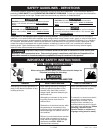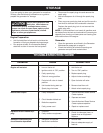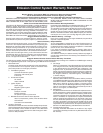
11 — ENG
D20346 Rev. 0 2/28/00
OBTAINING ELECTRICITY FROM
GENERATOR
There are basically two ways to obtain electricity from
a generator:
• Use of extension cords directly from the genera-
tor to the appliance, lights, tools, etc.
• Use of a double-throw transfer switch installed
directly to the main electrical supply outside of
the house.
Extension Cord
When using an appliance or tool at a considerable
distance from the generator, a 3-wire extension cord
that has a 3-blade grounding plug and 3-slot recep-
tacle that accepts the tool's plug MUST be used in
order to reduce the risk of electrical shock. A cord of
adequate size must be used. A minimum of 12 gauge
wire size with at least a 20 amp draw can be used.
When amperage exceeds 20 amps a 10 gauge wire
size should be used.
An extension cord that is hot
to the touch is overloaded.
Repair or replace damaged extension cords
immediately.
GENERATOR CAPACITY
Exceeding the rated capacity of your generator can
result in serious damage to your generator and
connected electrical devices. You should observe the
following to prevent overloading the unit:
• Starting and running wattage requirements should
always be calculated when matching a generators
wattage capacity to the appliance or tool.
• There are two types of electrical appliances that
can be powered by your generator:
A. Items such as radios, light bulbs, television
sets, and microwaves have a "resistive load".
Starting wattage and running wattage are the
same.
B. Items such as refrigerators, air compressors,
washer, dryer, and hand tools that use an
electrical motor have an "inductive load".
Inductive load appliances and tools require
approximately 2 to 4 times the listed wattage
for
starting the equipment. This initial load
only lasts for a few seconds on start-up but is
very important when figuring your total
wattage to be used.
NOTE: Some inductive appliances and tools will list
on the motor name plate, the starting and running
voltage and amperage requirements. Use the follow-
ing formula to convert voltage and amperage to
wattage: (Volts X Amp = Watts)
• Always start your largest electric motor first, and
then plug in other items, one at a time.
The guide is provided to assist you in determining the
appliances and tools that can be ran with the wattage
capacity of your generator.
Connecting Generator To Main Electrical
Supply
Potential hazards exist when a electrical generator is
connected to the main electrical supply coming into
the house. It is at that point that the generator could
feed back into the utility company’s system causing
possible electrocution of workers who are repairing
electrical lines. To avoid back feeding of electricity into
utility systems, a double-throw transfer switch
should be installed between the generator and utility
power. This device should be installed by a licensed
electrician and in compliance with all local electrical
codes.
NOTE: When installing a Double-Throw Transfer
Switch, a minimum of 10 gauge wiring must be used.


















